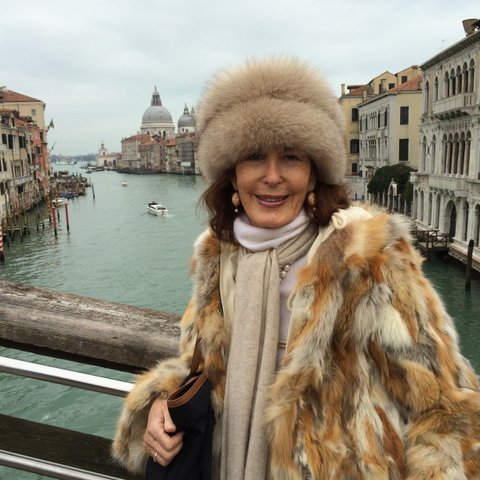
Author Ciji Ware on location in Venice researching her newest novel.
Marin County is home to many fabulous writers of varying fame and notoriety, but one of the most prolific may be New York Times best-selling novelist Ciji Ware who lives and writes in Sausalito. Ware has written ten novels and two books of non-fiction.
While her novels range widely in locale and the era in which they take place, they are all laced with romance and all are consistent in their keen attention to detail and factual, historical accuracy. Whether it’s an historical novel set in San Francisco in the aftermath of the 1906 earthquake, a biographical novel about the 4th Duchess of Gordon in 1800, or a more contemporary tale, the author’s relentless pursuit of factual accuracy is remarkable.
I can vouch for this –– because this writer had an opportunity to follow in Ms. Ware’s footsteps as she completed research for her current novel. And I use the word “follow” literally; I could barely keep up with this livewire who is 10 years my senior. But since the research was being done in Venice, Italy, somehow I managed.
Ware’s 11th novel, That Winter in Venice, is set in Venice, Italy and New Orleans. While it too is a romance, it also explores the world of costume design (an art form that the capitals of Mardi Gras and Carnevale have perfected) and the politics and challenge of rising water levels that both cities share.
A former journalist and Emmy-award winning TV producer, Ware is a stickler for factual accuracy and detail even though she is writing fiction. If the heroine is getting off the vaporetti at the Rialto stop, is it realistic that she would drag her huge suitcase over cobblestone streets and bridges all the way to her pensione in San Polo? Let’s get a bag and drag it from point A to B to make sure. And yes, we stayed at the same pensione to gather additional data.
And what restaurants would our young heroine patronize on her fashion intern’s budget? We took pictures of numerous trattoria candidates and actually ate at several of them so Ware could accurately chronicle the interior and the menu options. The tale may be make believe, but not so the context. How can the author accurately depict and write about the famous Carnevale ball Il Ballo del Doge at the Palazzo Pisani Moretta on the Grand Canal unless she actually goes to the party? (This research assistant was certainly game for this sort of research!) And if the heroine is going to intern with a famous costume designer, let’s meet with some of the best in Venice and learn from them what such a novice might actually be doing for a famous costume atelier.
Since the novel’s heroine and her boyfriend have a romantic dinner-date (and terrible fight I might add) at the Danieli Hotel, we went onsite to the legendary hotel and selected the exact table where they would dine so the author could accurately document the evening including the view. While so much of a story is clearly driven by a writer’s imagination, the setting and surroundings in which a story enfolds in all of Ware’s novels must be historically and factually correct. Again, the former journalist at work.
If I told of all the other sites and scenes and events we researched during winter (week) in Venice, it might spoil it for readers (the novel will be published this fall). Suffice it say, the book will be as much a realistic travelogue and snapshot of life and times in Venice as it will be a captivating tale of two cities and two hearts bound together by so many twists and turns.



